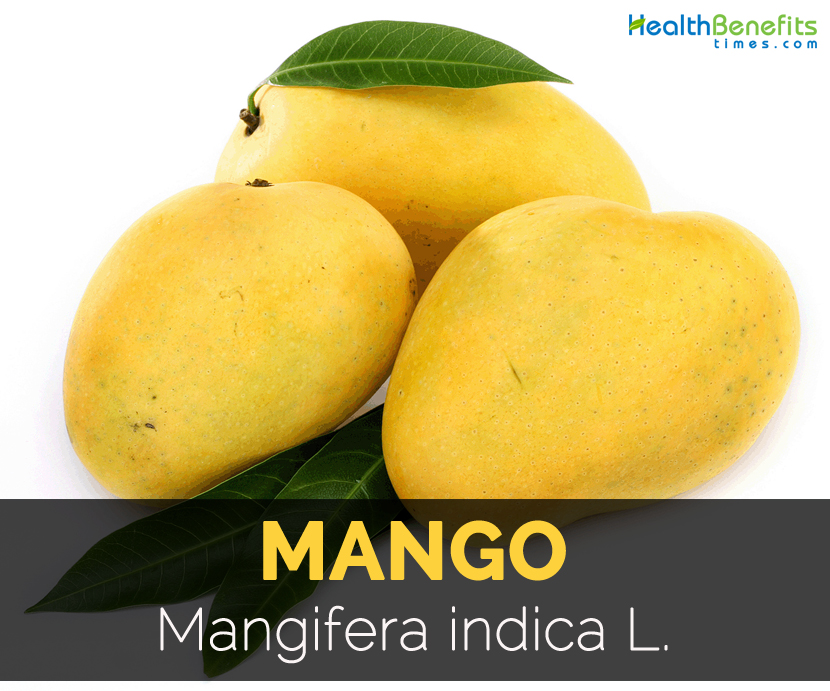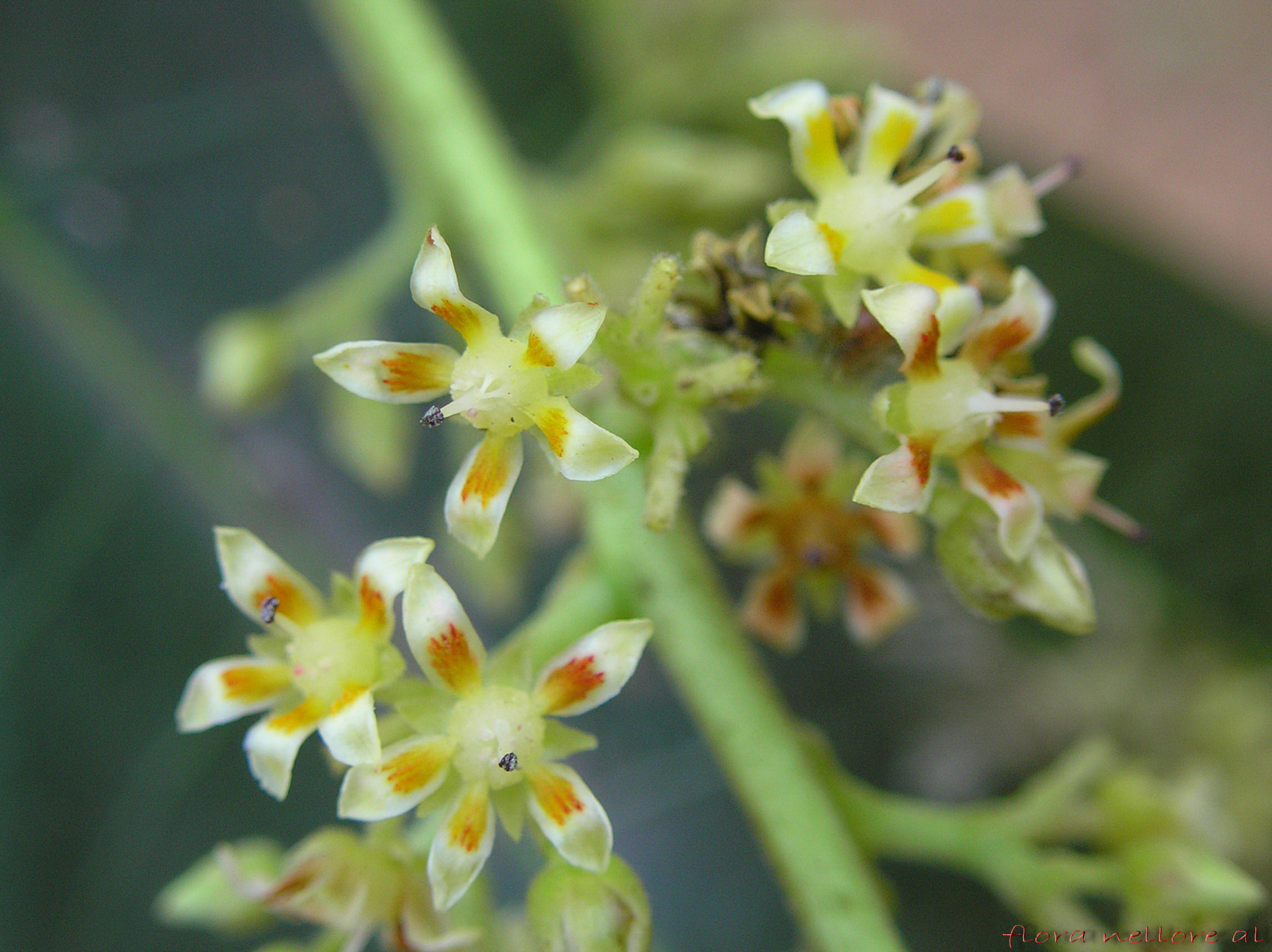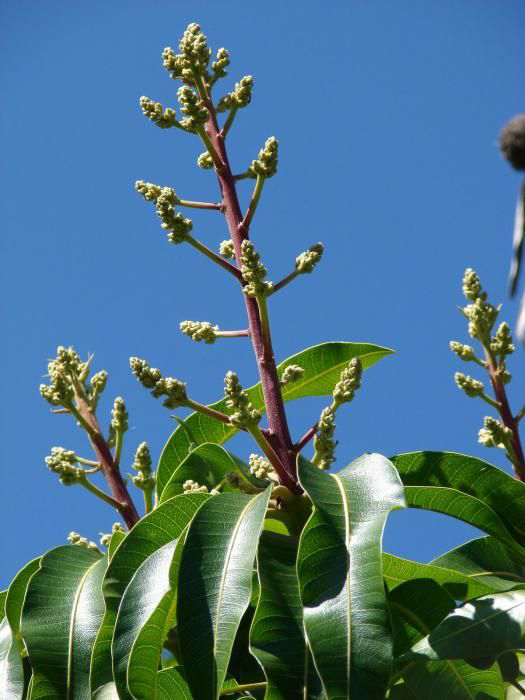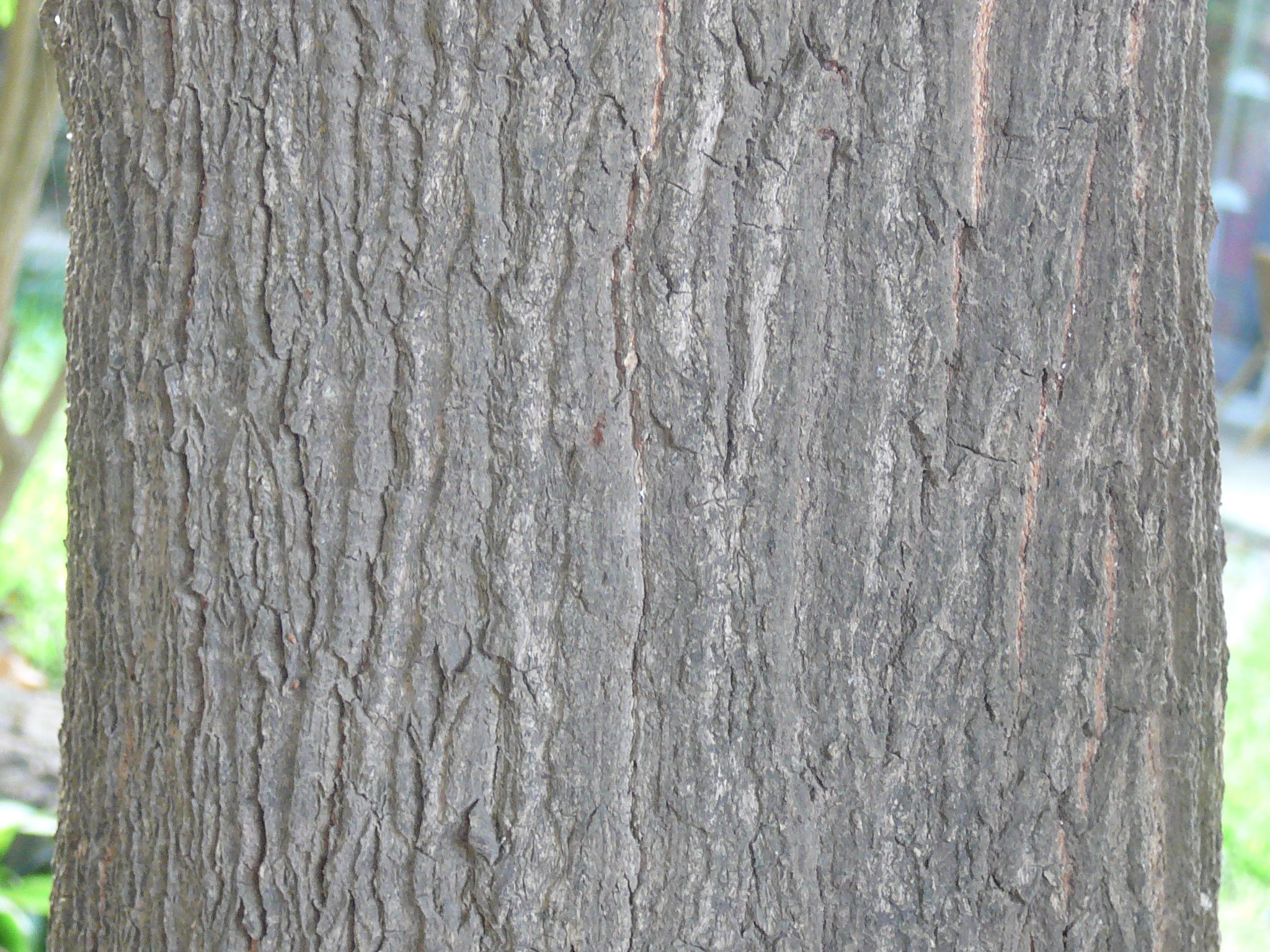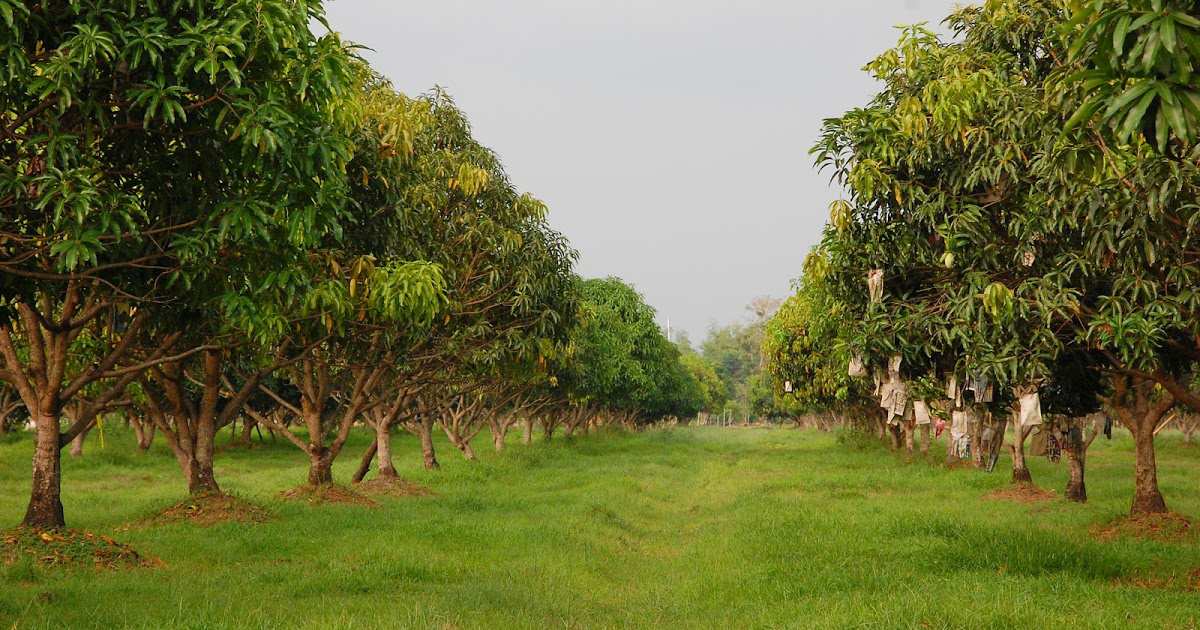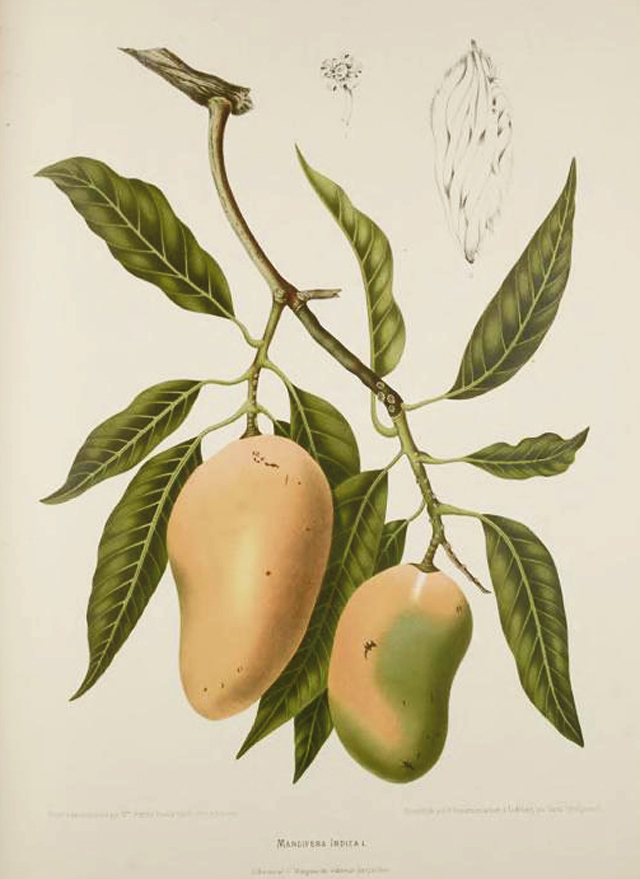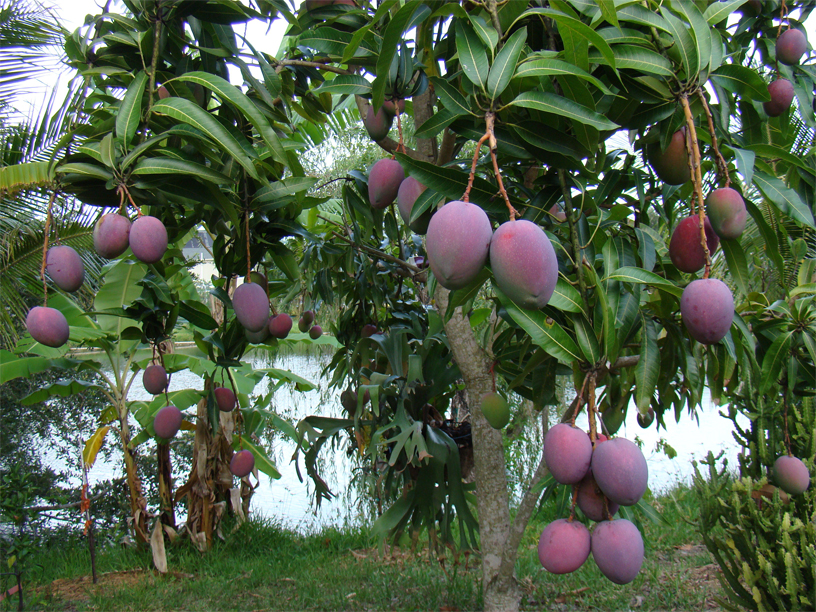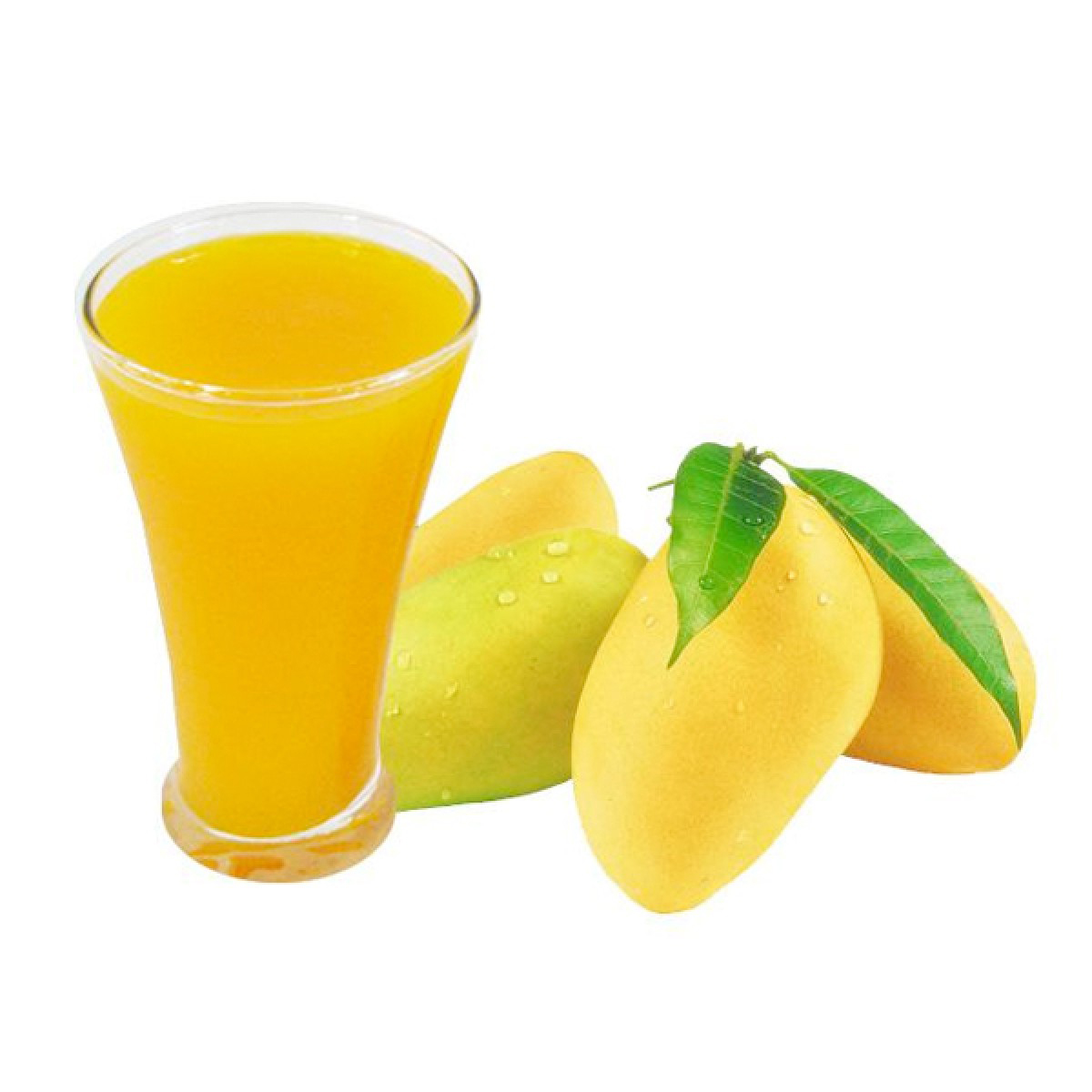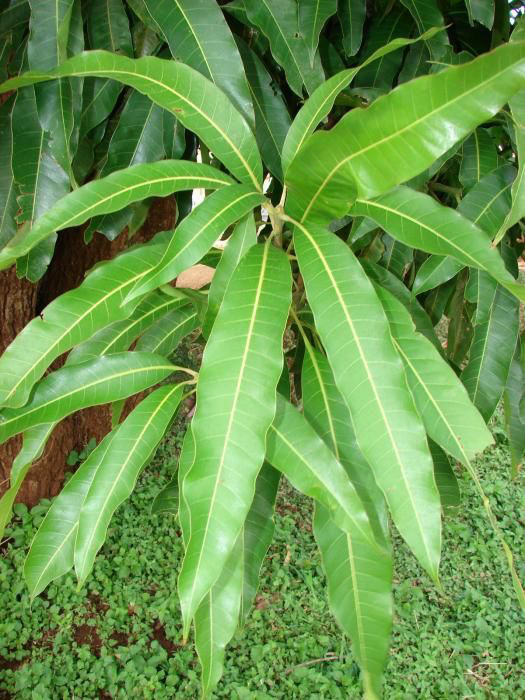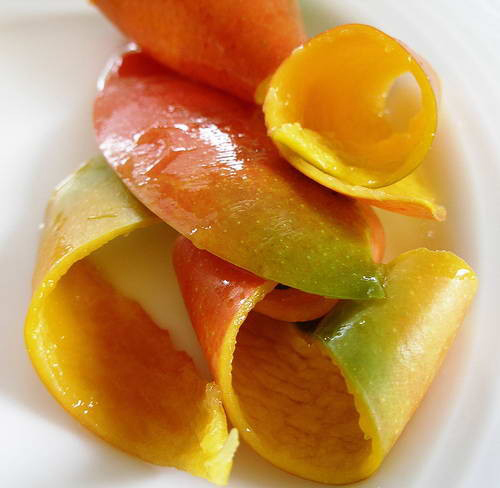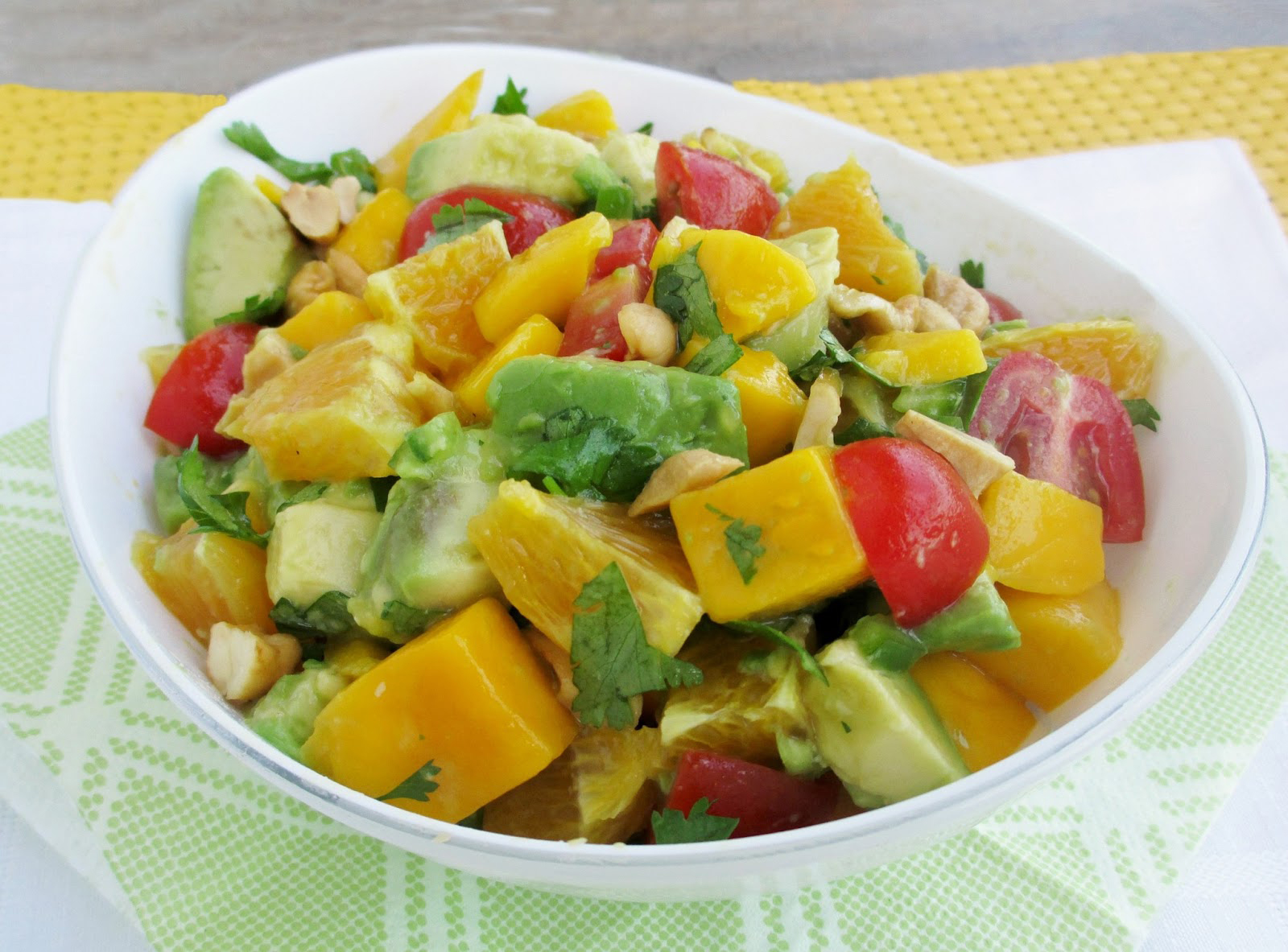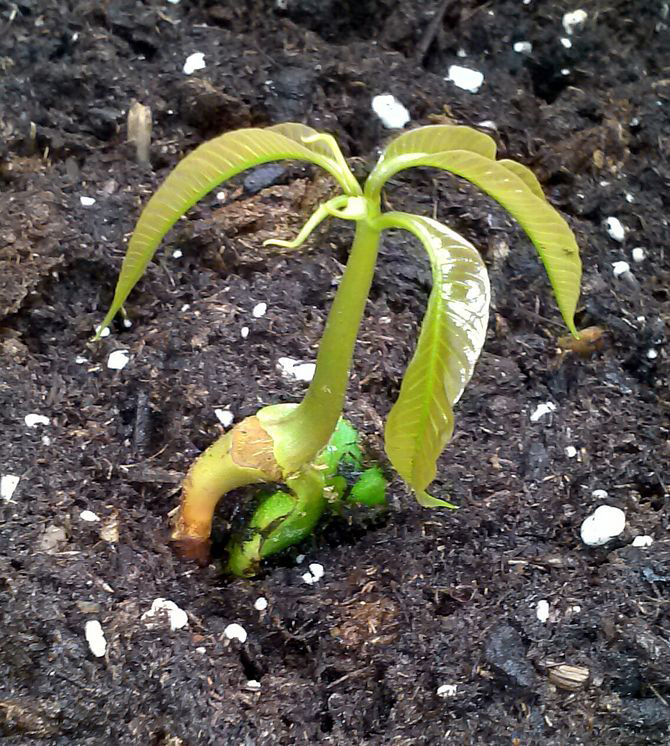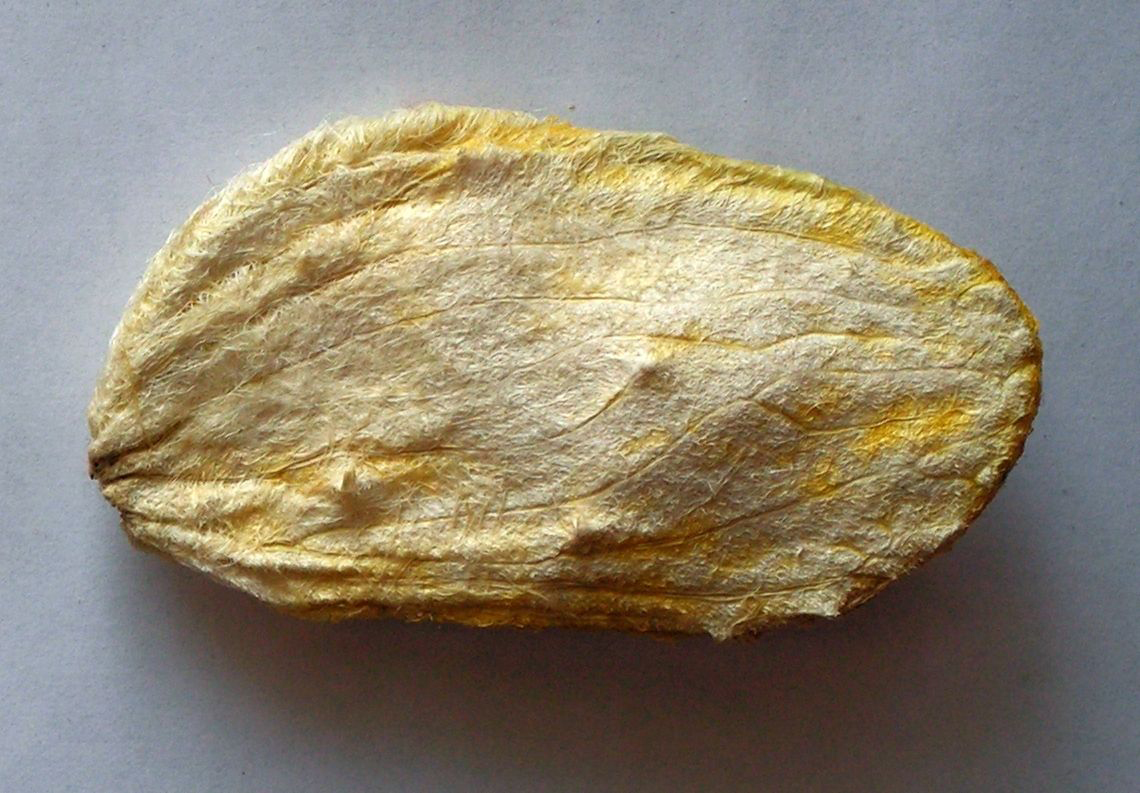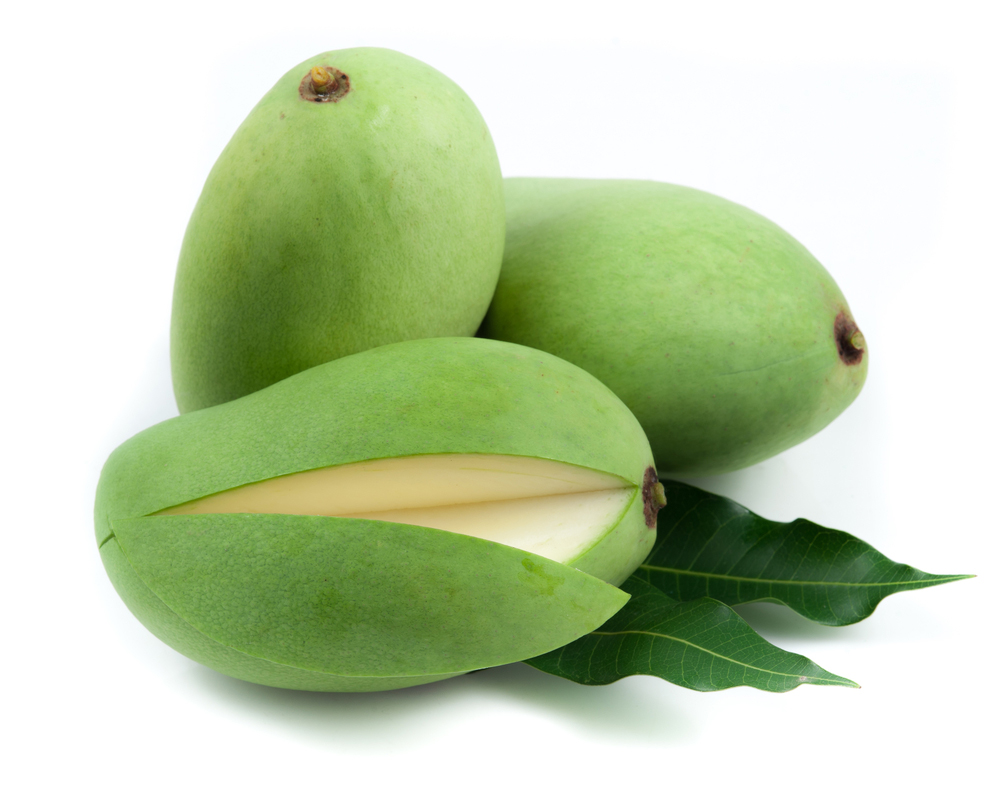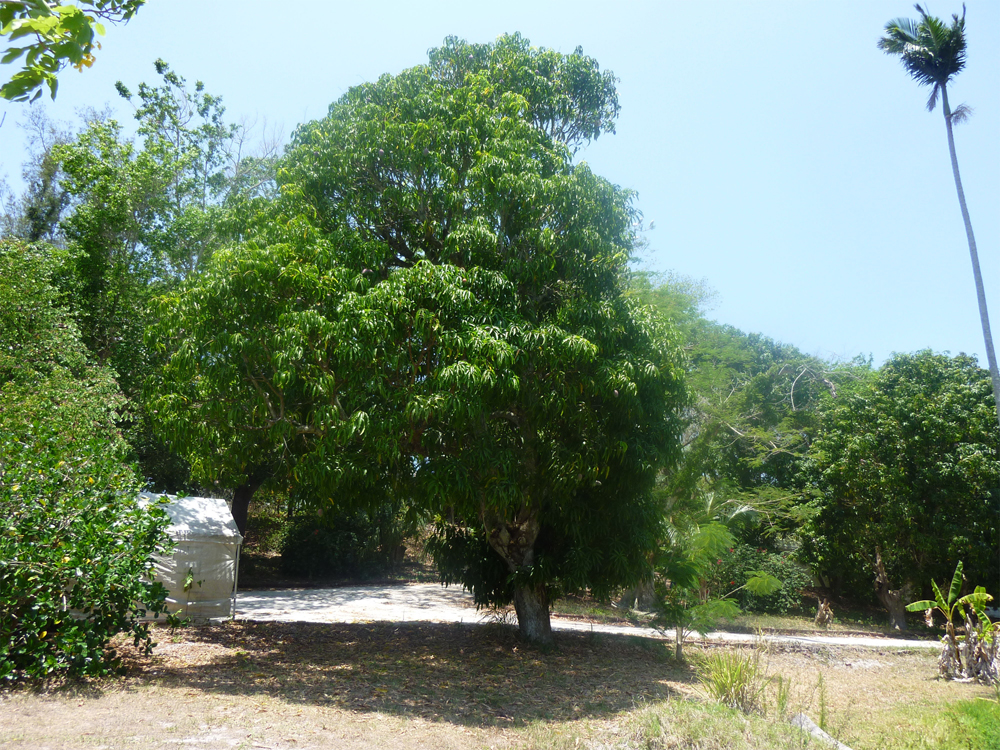| Mango Quick Facts |
| Name: |
Mango |
| Scientific Name: |
Mangifera indica L. |
| Origin |
Native to India and Myanmar. Originally it was found in foothills of Himalayas in Burma, Northeastern India and Bangladesh. It was domesticated for thousands of years ago. |
| Colors |
Green, yellow, red, purple with a dotted skin |
| Shapes |
2.5 cm to 30 cm long, round to oval, kidney-shaped or egg-shaped |
| Flesh colors |
Yellow, white |
| Taste |
Sweet, tart |
| Calories |
99 Kcal./cup |
| Major nutrients |
Vitamin C (66.78%)
Copper (20.33%)
Carbohydrate (19.02%)
Vitamin B9 (17.75%)
Vitamin B6 (15.08%)
|
| Health benefits |
Overall health, Lowers cholesterol, Breast cancer, Treat diabetes, Cardiac health |
Mango scientifically known as Mangifera indica L., is a flowering plant species in poison ivy and sumac family Anacardiaceae. Native to Indian subcontinent, it is inherent and cultivated varieties are introduced to other warm regions of the world. Mangoes are an evergreen tree which measures 10 to 30 m tall and trunk circumference of above 12 feet with dense crown, symmetrical and rounded canopy which ranges from low and dense to upright and open trunk and dense taproot. It has glabrous and brown branchlets. Leaves are alternate which borne in petioles of 2 to 6 cm long and is shallowly grooved apically as well as inflated basally. It has simple and variable lamina in lanceolate to ovate or oblong to oblong lanceolate measuring 12 to 45 cm long by 3 to 12 cm wide. It has acute to long acuminate apex, cuneate to obtuse base with 18 to 30 pairs of lateral veins and midrib distinct on both sides. Leaves are light green when young which turns into deep green when mature. It bears narrowly to broadly conical inflorescences, pseudoterminal, 20 to 45 cm long, glabrous to tomentose pilose having lanceolate, pubescent bracts which bears hundreds of fragrant and subsessile to shortly pedicellate male and hermaphrodite flowers. The small hermaphrodite flowers are 5 to 10 mm having four to five ovate lanceolate, four to five oblong, lanceolate and yellowish petals. Fruit is a fleshy yellow to orange drupe which is smooth to firbrous mesocarp which is surrounded by a leathery laterally compressed by endocarp which contains single seed. Fruit are globose to ovate, obovate to oblong to elongate in shape. It has green to pale green and yellow skin. When ripe it have blushes of orange, pink, purple and red which depends on variety.
Mango is regarded to be one of the best tropical fruits. This species was domesticated in India around 2000 BC. From India, the species was brought around 400 to 500 BCE to East Asia, in 15th century to Philippines and in 16th century to Africa and Brazil by Portuguese. In 1753, the species was described by Linnaeus for science. It is the national fruit of Pakistan, India and Philippines. The tree is regarded as the national tree of Bangladesh. India and Pakistan is considered to be the main suppliers of Western Asia & Thailand and Philippines are the main suppliers of Western Asia. Pharmacological activities such as antitumor, antioxidant, antiallergic, immunomodulatory, antidiabetic, anti-inflammatory, antiviral, antiulcer, antibacterial, antifungal and antiparasitic properties are found in Mangifera indica L. It contains indicol, pentacyclic terpene, sugars, β-sitosterol and glycosidic substance. Leaves possess volatile oil which contains ethyl, methyl, isobutyl and amyl alcohols and ethyl acetate.
Tree
Mango tree is evergreen grows from 10 to 40 m high with symmetrical and rounded canopy which ranges from low and dense to upright and open. It has dark grey to brown to black bark which is smooth and superficially cracked. Exudate of live bark is transparent, drying brown, dark yellowish brown which consists of resin combined with gum. Bark consists of 15% gum and 78% resin with tannic acid. The twigs are smooth, glabrous, apically angular, dark green and glossy.
Root
Tree has long and unbranched taproot which measures up to 6-8 m and dense mass of superficial feeder root that develop at trunk base or slightly deeper. It produces anchor roots and feeder roots sometimes develop above water table. Fibrous root system broader away from drip line.
Leaves
Leaves are simple, alternately arranged, exstipulate and measures 15 to 45 cm long. It has 1 to 12 cm long petioles which are swollen at base. It is grooved on upper side. Leaves are arranged closely at tips which appear to be whorled. Leaves are oval to lanceolate, oblong, lanceolate, ovate, linear to oblong, roundish to oblong and obovate to lanceolate. An apex is acuminate to nearly round. The entire margin is slightly wavy, undulated, folded or rarely twisted. An upper surface is dark green and shiny and lower surface is glabrous light green. The leaves are flaccid, pendulous while young and appear in flushes. Young leaves are tan-red, yellow to brown and pink in color. The color later on chances from tan-red to green and pass through various shades becomes dark green when mature.
Inflorescence
The tree bears an inflorescence which is narrowly to broadly conical panicle measuring 45 cm long that depends on cultivar and environmental conditions. It is bracteates or ebracteate. Bract is elliptical, concave and leafy. The panicle is yellowish to green or light green having crimson patches. An inflorescence is pubescent which might be glabrous sometimes. The panicle bears about 500 to 600 flowers in which 1 to 70% are bisexual and remaining are male depending on cultivar and temperature during development.
Flowers
The male and hermaphrodite flowers are formed in same panicle which is usually larger. Male and hermaphrodite flowers measures about 6 to 8 mm diameter. It is rarely pedicellate, subsessile and possesses sweet smell. The short pedicles are articulate having panicle branch of same diameter. Calyx is fivepartite and lobes are concave and ovate to oblong. Corolla has five pale yellow petals and three to five ridges on ventral side. It bears pink anther which turns to purple at the time of shedding. It has sessile and one celled ovary which is oblique and is slightly compressed. An ovule is pendulous and antrapous showing one sided growth.
Fruit
Fruit is a fleshy drupe which is more or less compressed and varies in shape, size, color, flavor and taste. The main characteristic feature of this fruit is the formation of small conical projection that develops laterally at proximal end of fruit which is called beak. Above the beak, a wide sinus is present. A pistillate area of fruit is found near the base of beak called nak. The fruit is rounded to ovate-oblong or longish and its length varies from 2.5 to 30 cm in contrasting varieties. The base is elevated or depressed or intermediate. The skin color shows different mixtures of yellow, green and red shades. Skin might be rough or smooth.
Health Benefits of Mango
Mangoes have low content of cholesterol, saturated fat and sodium. It is a great source of Vitamin B6, dietary fiber, Vitamin C and Vitamin A. High content of minerals such as copper, magnesium and potassium, astragalin, beta carotene and quercetin could be found in mangoes. Mangoes are a great source of dietary fiber, minerals, vitamins and poly-phenolic flavonoid antioxidants. It also possesses an adequate amount of Vitamin A and potassium. Vitamin A assist in bone growth, vision, healthy mucous membranes and skin. The serving size of 100 grams of mangoes provides 156 mg of potassium and 2 mg of sodium. Potassium is essential to normalize blood pressure and heart rate. It controls level of homocystiene in blood. Bark, leaves, stem and roots contain mangiferin which prevents harmful effects of radiation. Bark possesses anti-inflammatory, antioxidant and immunomodulatory properties. Besides various minerals and vitamins, it contains flavonoids such as aphacarotene, betacarotene and beta-cryptoxanthin that provide antioxidant activities which assist in neutralize free radicals from the body that causes premature aging, heart diseases, degenerative diseases and cancer.
- Overall health
Mangoes are loaded with vitamins which promotes overall health. It is rich in magnesium and potassium which helps to cure high blood pressure. It possesses calcium, selenium, phosphorus and iron. This fruit is rich in Vitamin B6, riboflavin, Vitamin C, Vitamin A, Vitamin K, Vitamin E, folate, niacin and pantothenic acid. It assists to prevent host of diseases which arises from deficiency of minerals and vitamins. Vitamin E promotes sex life by enhancing the activity of sex hormones. The present study showed multifaceted activities of mango and its phytochemicals which helps to counteract pro-inflammatory molecules and health problems such as cardiovascular diseases, cancer, aging and neurodegenerative disorders. (1)
- Lowers cholesterol
The methanol extract of Mangifera indica L. showed cholesterol lowering activity when provided 90 mg/kg for 6 weeks treatment and lowered in plasma triglycerides which was also examined on the treatment with extract. 3β-taraxerol, mangiferin, and iriflophenone-3-C-β-glucoside was found in leaf methanol extract in 0.49% w/w, 4.6% w/w and 2.37% w/w respectively. Methanol extract of Mangifera indica leaf is considered to be safe after oral examination of single dose of 5000 mg/kg body weight to female albino Wistar rat. (2)
- Breast cancer
The extract of Mangifera indica found to be cytoxic to both estrogen negative and positive breast cancer cell lines in comparison to normal breast cells. An antioxidant bioactives provide synergistic effects that contribute to cytotoxic effects of extract. Mangifera indica extract possess anticancer activities against breast cancer cells. The therapeutic potential is tremendous and could be used as an alternative for various therapy used currently to treat breast cancer. Yet it is required to identify actual components which are responsible for cytotoxicity and isolate them and to study its effect in vivo to make sure its effectiveness or any side effects. This extract could play a vital role in future studies for managing breast cancer. (3)
- Treat diabetes
Mango kernel flour is a great source of flavonoids as well as phenolic acids and its methanolic extract helps to inhibit some enzymes associated to pathology complications associated with type 2 diabetes. The study shows antidiabetic activities when fed to type 2 diabetic rats. The supplementation of Mango kernel flour showed a significant improvement in blood glucose, glycosylated hemoglobin, hepatic glycogen, lipid profile, hepatic and pancreatic malonaldehyde, plasma electrolytes and liver function markers of diabetic rats in comparison to diabetic control rats. The conclusion shows that Mangifera indica kernel flour provide antidiabetic effects on type 2 diabeteic rats and promising nutraceutical therapy to manage type 2 diabetes as well as its complications. (4)
- Cardiac health
The study was conducted to evaluate cardio protective effect of alcoholic leaf extract of mangoes against cardiac stress which is caused by doxorubicin (DOX). It is concluded that DOX induced cardiac stress could be prevented with the use of alcoholic extract of mango leaves to higher extent. No preset guidelines are there to prevent cardiotoxicity caused due to anticancer agents. It is helpful for the patients of chemotherapy associated complications of heart. The studies could be further conducted or designed clinically. (5)
- Promote brain health
Mangoes are packed with ample amounts of Vitamin B6 that is essential to maintain and improve brain function. It supports amalgamation of vital neurotransmitters which helps to determine mood and modify sleeping patterns. It naturally provides meaningful amounts of Vitamin when included in diet. It results in healthy brain with effective functioning of nerves. It is better to avoid medicinal supplements that provide various side effects. Mangoes have glutamine acid content that promotes memory and concentration.
- Cure for acne
Mangoes are useful to maintain skin health. It helps to provide a healthy glow to face and also lightens the skin color. This fruit helps to enhance the beauty if consumed regularly. It helps to treat acne by opening the clogged pores on skin. When the pores are opened the formation of acne will stop eventually. The most effective way to erase acne is to unclog the pores of skin. Besides its consumptions, apply the pulp on the skin for about 10 minutes and then wash it.
- Losing weight
The studies have shown the importance of mango fruit with its skin. The phytochemicals are found on peel of fruit which acts as natural fat busters. Mango peel also assists in weight loss. It contains fiber which contributes a huge role towards weight loss. It is proved that the dietary fiber obtained from the intake of fruits and vegetables supports weight loss. It is associated to the ability of fiber to lower the intake of food.
- Vision health
Eyes are the vital organs of the body. Mangoes provide beta carotene and Vitamin A which helps to enhance eye health. The deficiency of Vitamin A results in blindness. Vitamin A is essential for vision and eye health and is essential for functioning of retina optimally. Zeaxanthin and lutein are the two major carotenoids of human eye. Mangoes are a great source of zeaxanthin which assist in promoting eye health. The fruit contains carotenoid known as cryptoxanthin which helps to lower the chances of age related macular degeneration.
- Promotes immune function
Mangoes are rich in Vitamin C which plays a vital role to strengthen immune function. Besides Vitamin C content, mangoes are a great source of zinc which plays a vital role to maintain overall health of immune system. Vitamin C helps to lower severity of allergies and also counteract various infections. It protects the cells of body from reactive oxygen species which are formed by immune system to eliminate pathogens.
https://www.youtube.com/watch?v=MKyWsQ_T1Z8
Types of Mango fruit
Very well, there are far more than one hundred kinds of mangoes accessible across the world. Generally particular kinds are normally found that are full of taste in sub-continent among others can be found in Southeast Asia as well as the rest of the world. Pakistan also offers various and really delicious types of mangoes because the physical location of Pakistan and its particular weather offers very best appropriate atmosphere the place where a mango tree can easily develop effortlessly. Most well-known kinds of mangoes generally present in Pakistan could be called as.
1. Chaunsa:
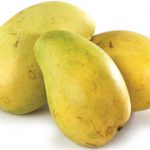 The title Chaunsa actually indicates “to suck.” This particular golden colored jewel is really a genuinely heavenly fruit and is also well known because of its sweet taste, aroma as well as structure. The Chaunsa turns golden yellow on maturing prompting many to call it “The food of the Kings. “ It features a very large pulp and as its title implies, makes you wish to suck out each and every drop of its superb sweet taste. It is very succulent and that causes it to be a popular along with juice lovers.
The title Chaunsa actually indicates “to suck.” This particular golden colored jewel is really a genuinely heavenly fruit and is also well known because of its sweet taste, aroma as well as structure. The Chaunsa turns golden yellow on maturing prompting many to call it “The food of the Kings. “ It features a very large pulp and as its title implies, makes you wish to suck out each and every drop of its superb sweet taste. It is very succulent and that causes it to be a popular along with juice lovers.
It really is regarded as probably the greatest variety of mangoes obtainable in Pakistan because of the flavor it’s got as well as the richness it owns. It is almost always made available from July to the start of September.
The Chaunsa season will last from the last week of June to the start of August.
2. Langara:
 This really is probably the most outstanding types of Mango from the Northern Indian sub-continent. It possesses a great green skin and contains brown yellow color. It features a extremely fairly sweet pulp. Therefore it is ideal in making the mango juices as well as mango smoothies. It brings the image of the individual whose objective in life is care free joy and pleasure!!
This really is probably the most outstanding types of Mango from the Northern Indian sub-continent. It possesses a great green skin and contains brown yellow color. It features a extremely fairly sweet pulp. Therefore it is ideal in making the mango juices as well as mango smoothies. It brings the image of the individual whose objective in life is care free joy and pleasure!!
Langra lovers usually live their life for Langra. For them, there are just a couple of states of life: Life-with-Langra as well as Life-without-Langra!! The lengthy Life-without-Langra is invested excitedly waiting for the Life-with-Langra. The Langra keeps its greenish touch throughout the maturing procedure. It provides out a fairly sweet maturing odor whenever ripe and is also packed with juice as well as pulp!!
The optimum time for this Mango is throughout the last two weeks of July.
3. Sindheri:
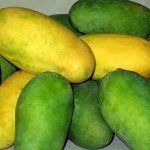 Major variety from the Sind province of Pakistan, just the thought of the mango can hold someone to the heavenly tone of the mango tree, basking during the summer time sun awaiting the next ripe mango to fall into your lap.
Major variety from the Sind province of Pakistan, just the thought of the mango can hold someone to the heavenly tone of the mango tree, basking during the summer time sun awaiting the next ripe mango to fall into your lap.
It has the flavor much like a Chaunsa kind of mangoes however, not in fact has got the same flavor in general.
Its origins are from Mir Pur Khas within the Sindh province of Pakistan. Its high season is from mid-may to mid-June.
4. Dusehri:
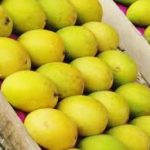 Probably the most scrumptious Dusehri Mango from Pakistan. Its flavor is extremely sweet and different It really is mainly grown in the area of Mir Pur Khas as well as Hyderabad, the province of Sindh. Pakistan may be the 3rd largest Exporter of Mango on the planet. Colour is yellow-colored whenever ripe, skin thin pulp fiber less, flesh firm, extremely sweet in flavor, stone really small, keeping as well as peeling qualities good.
Probably the most scrumptious Dusehri Mango from Pakistan. Its flavor is extremely sweet and different It really is mainly grown in the area of Mir Pur Khas as well as Hyderabad, the province of Sindh. Pakistan may be the 3rd largest Exporter of Mango on the planet. Colour is yellow-colored whenever ripe, skin thin pulp fiber less, flesh firm, extremely sweet in flavor, stone really small, keeping as well as peeling qualities good.
Colour is yellow-colored whenever ripe, skin thin, pulp fibreless, flesh firm, extremely sweet in flavor, stone really small, mid-season (July), keeping as well as peeling qualities good.
5. Anwar Ratole
 This particular mango is considered to have been grown by Anwar-ul-haq within a garden in the Ratol area in the state of Uttar Pradesh in India. It is just a little mango as well as fairly sweet as sin. Its taste is definitely the major reason for its reputation in recent years. It really is thoroughly developed within the Punjab province of Pakistan.
This particular mango is considered to have been grown by Anwar-ul-haq within a garden in the Ratol area in the state of Uttar Pradesh in India. It is just a little mango as well as fairly sweet as sin. Its taste is definitely the major reason for its reputation in recent years. It really is thoroughly developed within the Punjab province of Pakistan.
Its high season comes from mid-July to August.
6. Alphonso
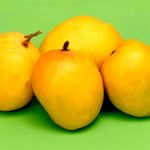 The Alphonso Mango is termed after Afonso de Albuquerque. This was a superb as well as pricey variety of mango, which he utilized to bring on his trips to Goa. The locals took to calling it Aphoos in Konkani as well as in Maharashtra the pronunciation got further more changed to Hapoos. This particular variety then was delivered to the Konkan region of Maharashtra along with other areas of India.
The Alphonso Mango is termed after Afonso de Albuquerque. This was a superb as well as pricey variety of mango, which he utilized to bring on his trips to Goa. The locals took to calling it Aphoos in Konkani as well as in Maharashtra the pronunciation got further more changed to Hapoos. This particular variety then was delivered to the Konkan region of Maharashtra along with other areas of India.
The Alphonso is recognized as the “king of the fruits” and is also much preferred in both India as well as in another country. As a result of the shortage, costs have increased significantly.
Ratnagiri is really a tiny heavenly seaside town – 330 kilometres south of Mumbai. It really is renowned for golden Haapus or Alfonso mangoes as well as the horse shoe shaped fort.
7. Sammar Bahisht
 Sammar Bahisht (in Urdu Sammar signifies fruit as well as Bahisht means Paradise) is really a mango cultivar cultivated in various areas of the planet.
Sammar Bahisht (in Urdu Sammar signifies fruit as well as Bahisht means Paradise) is really a mango cultivar cultivated in various areas of the planet.
It originated as an excellent chance seedling in Muzaffarnagar Uttar Pradesh, India. It got its title for the enjoyable taste. The fresh fruit is moderate having a somewhat compressed base, equal shoulders, greenish yellow skin, as well as yellow pulp. It features a extremely sweet, pleasurable taste and is also sparsely fibrous. The fruit in addition maintains effectively as well as peels easily. It ripens from July to August.
8. Fajri Mango
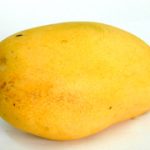 Fajri is actually a huge size mango. Fajri has got tiny aroma however the pulp is fiber less. Accessibility is from 15th June to 5th August.
Fajri is actually a huge size mango. Fajri has got tiny aroma however the pulp is fiber less. Accessibility is from 15th June to 5th August.
In both its green as well as ripe type is an extremely excellent tenderizing agent and for that reason perfect to incorporate in any kind of gravy. In Pakistan they’ll use a bitter mango powder that contains ground up green mangoes known as Achar, both equally like a flavoring as well as tenderizing aid.
Traditional uses
- In Philippines, decoction made from root is used as an astringent and resin obtained from tree is used to cure aphthae.
- In Kampuchea, bark is astringent and used for leucorrhoea and rheumatism.
- Swallow the gum obtained from bark for dysentery in India and Kampuchea.
- Mix the gum resin with coconut oil and apply it to scabies and other parasitic diseases of skin.
- The bark infusion is used as an aid for mouth infections in Samoa.
- Leaf juice is used for bleeding dysentery.
- Use the decoction made from leaves by adding honey for loss of voice.
- Young leaf infusion is used for chronic diseases of lungs, coughs and asthma.
- The ashes of leaves are used as an aid for scalds and burns.
- Leaves are used to prepare tea in Philippines.
- The dried flowers of mango are used in decoction for diarrhea, gleet and chronic dysentery.
- Consume a half ripe fruit with salt and honey to treat gastro-intestinal disorders, blood disorders, bilious disorders and scurvy.
- The juice of ripe mangoes useful for treating Vitamin A deficiencies such as night blindness and treat constipation and atomic dyspepsia.
- In India, resins are used to cure scabies and cutaneous affections.
- The powdered form is used for chronic dysentery, obstinate diarrhea, asthma and bleeding piles.
- In Johore, Malaysia, seeds are used for menorrhagia, roundworms and piles.
- Mango can cause contact dermatitis.
- In Ayurveda, it is used to clear acidity and digestion due to pitta.
- Drink an infusion to lower blood pressure and treat various conditions such as asthma, angina, diabetes and coughs.
- Use the leaves externally in convalescent bath.
- Prepare mouthwash from leaves for hardening gums and treat dental problems.
- Leaves are useful in treating skin irritations.
- Leaves (charred and pulverized) are used to eradicate warts.
- It is used for treating colds, coughs, bleeding piles and obstinate diarrhea.
- It is used to treat throat problems and hemorrhage.
- Use the decoction prepared from leaves to treat diarrhea, fever and toothache.
- Young leaves are used for diarrhea in Chittagong.
- In India, bark is used to treat rheumatism and diphtheria.
- The resinous gum obtained from trunk is used on crack of feet and scabies.
- In Caribbean, decoction made from leaves is an aid for fever, diarrhea, diabetes, chest complaints, ills and hypertension.
- Use the decoction of mango and other leaves after childbirth.
- Mango assist resistance to counteract germs and afflictions.
- It is used to soothe stomach.
Precautions
- The ingestion of mango might cause rash similar to poison ivy in sensitive people.
- Avoid over consumption of this fruit.
- If consumed more, it enhance the level of blood sugar, cause diarrhea and gain in weight.
- A white substance found in raw mangoes may cause allergy to some people.
- People might experience runny nose, watery eyes and anaphylactic shock.
- The sap of mango causes allergies and blisters.
- Allergic people should avoid it.
How to Eat
- Mango fruit is consumed in immature green or when ripe.
- Immature mangoes are consumed as pickled mangoes or also used in curries.
- Add green mangoes to the fruit salad.
- It is added to various recipes.
- The Vietnamese recipe of green mango salad consists of ram-ram, sliced green mangoes, sliced red onion, mint, coriander, brown sugar or grated palm sugar, fried shallots, lime juice, crushed garlic, vinegar or fish sauce.
- Thai recipe consists of dry shredded unsweetened coconut, julienned green mango, sliced spring onions, bean sprouts, chopped fresh coriander, fresh basil, cashews or chopped peanuts, soy sauce or fish sauce, lime juice, chilli, Thai chilli sauce and brown sugar.
- Green mango is consumed with sauce or shrimp paste in Philippines.
- Mango is consumed green with pepper, salt and hot sauce in Central America.
- In Guatemala, green mangoes are followed with ground and toasted pumpkin seed with salt and lime.
- An unripe green mango could be cooked or processed into various products.
- Make chutney by peeling, slicing and parboiling green mangoes with salt, sugar and various spices and cook with other fruits and raisins.
- It could be sun dried, salted and used in pickles.
- Make a relish with ripe or green mangoes.
- In India, green mango is used as pickle, amawat, murraba, amchur, chatni, sukhawata or chutney.
- In Malaysia, India and Thailand, unripe flesh of green mango is popular.
- The peeled and sliced green mature mangoes are used as a filling for pies, sauce, used for jelly and also converted into sherbet.
- In Philippines, green mango is made in green mango jam, dried green mangoes, green mango wine and puree.
- In Australia and India, mangoes are used to make alcoholic beverages such as liquors and wines.
- In Java, flour is made from seeds.
- In Indonesia, young tender leaves are consumed fresh.
- It is used to make preserves, jams, chutney, pies, jellies and ice cream.
- Eat unripe mango with fish sauce, bagoong, soy sauce, vinegar or with dash of salt.
- In Central America, it is consumed with vinegar, salt, hot sauce and black pepper.
- Mash mango and use it as a topping on ice cream or blend it with milk or ice as milkshakes.
- Seed is useful for pitta, cough, chronic diarrhea, helminthiasis, haemorrhages, dysentery, haemorrhoids, haemoptysis, bruises, ulcers, diabetes, menorrheagia, vomiting and heat burn.
Other Facts
- The mango blossoms are a source of nectar for honey bees.
- Leaves are fed to rabbits.
- Mango is considered to be the national fruit of Pakistan, India and Philippines.
References:
http://www.hear.org/pier/species/mangifera_indica.htm
http://www.pfaf.org/user/Plant.aspx?LatinName=Mangifera+indica
https://www.itis.gov/servlet/SingleRpt/SingleRpt?search_topic=TSN&search_value=28803#null
http://www.horticultureworld.net/botany-taxonomy.htm
https://medinfo.org/amazing-facts-health-benefits-of-mango-fruit
http://www.stylecraze.com/articles/health-benefits-of-mangoes/#gref
https://www.organicfacts.net/health-benefits/fruit/mango.html
Comments
comments


